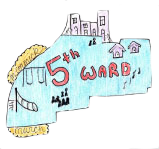Fifth Ward Needs a School

Illustration by Rose McRodain
October 4, 2018
If you grew up in Evanston, your school was likely a hop, skip and a jump away. Unfortunately, this is not true for students who live in the fifth ward. Despite historic efforts to change this issue, there are no schools located in this area of Evanston.
A major concern regarding this is the racial demographics of the fifth ward. It is the most black and brown ward in Evanston with 44.2% of the population identifying as people of color. Due to these demographics, this issue could be identified as institutional racism, a form of racism that is systemic and enforced through social institutions. If this issue were resolved, we would see more racial equity within our Evanston community. It’s time the North Shore focuses on issues like these.
This topic is a national trend. Several low income communities in our country have less access to resources that are easily provided to more privileged communities. The fifth ward situation also resembles desegregation, an effort to integrate U.S. schools by bringing black students to white schools. Despite school segregation being ruled unconstitutional in 1954 by Brown v. Board of Education, integration didn’t occur until much later. This took place because neighborhoods were heavily segregated, making it difficult for black students to commute to white schools. Busing began in the 1970’s; however, the way that it was implemented was unfair to the black students, who often spent tiring hours in these buses. Obviously, fifth ward residents are not spending several hours on their commute; however, the situation is still inequitable. There has been great number of actions taken to solve this schooling issue for the students, but the fifth ward is still lacking a school.
“Having a school in the fifth ward would provide a public school option that is within a safe walking distance,” says Henry Wilkins, an advocate for opening a STEM school in the fifth ward. The current situation makes biking, walking and getting a ride require much more time for fifth ward students and their families than other families in different wards of Evanston.
The previous existing school in the fifth ward was Foster School. In 1967, the school was shut down and transitioned into a laboratory. Eventually, this laboratory moved locations. Generations of fifth ward residents have experienced the consequences of this, including longer routes of transportation and switching between different elementary and middle schools. 50 years is more than long enough for the ramifications of this issue to prevail.
Some Evanston residents may argue that the implementation of a school in the fifth ward would minimize diversity in Evanston schools. Many students of color are bused from the fifth ward. However, the fifth ward students are ultimately the ones affected. They are the ones who have to wake up earlier than other students every day and get home a little later. So one thing to ask ourselves is if we want the Evanston community to “look good” by fostering diversity or strive towards justice for the fifth ward students.
“Some people might think it’s just a building, but what the school does is it brings people together,” Wilkins comments. As North Shore residents, it is no secret that many resources such as schools are easily accessible and are imperative towards building a sense of community. However, there is still one area in Evanston without a school, that happens to be the most heavily black and brown. This aspect consequently makes our city look bad. The solution is simple: Collectively, it is our responsibility to take action towards pushing for a school being built in the fifth ward. This can be accomplished by contacting local officials, petitioning for a new school and bringing the issue to the attention of other Evanston residents.
“What helps is getting the community involved and energized in terms of pursuing what they can do to help,” Wilkins explains.
It’s about time we put an end to the matter, and ease the burden on the lives of students who also deserve the luxury of a nearby school.










Margarita Matlis • May 13, 2021 at 10:23 am
I would add some comments to this piece: I walked my 4 kids to Orrington school. I was able to meet many other moms at the door and able to pick up important tips about the school, the teachers, principal and other very useful ideas from them. And very importantly, make new friends with whom to compare notes about the school and classes and get new ideas and suggestions from parents whose kids were in the same class as mine. It was important for me to get to know those ladies when I needed help on school issues. By being there every morning I was also able to personally meet and chat with the teachers and principal and this way become part of the school community and make sure things were going all right for my kids. Also very importantly, the teachers were able to know and establish a connection with the parent or parents of the kids that she or he taught in their classrooms.
At the same time my kids were able to make friends with other kids in the neighborhood so they could then easily meet at theirs or our homes that were at walking distance, and I was able to personally meet them at school, and get an idea of who they were and what they and their parents were like. My kids were able to take part in after school programs and I was able to meet informally with their teachers after school. My kids and I would have not had any of this if they had to be bused every day in and out.
I understand the 5th ward was able to do the same once upon a time. People and kids made friendships just like I did. Foster school was like a social center as well as a school. Parents and kids got to know each other and made new friendships. Parents also became –like me—a part of the school community. People in the 5th ward were so happy with their Foster school and what it did to their community that they used to call their ward, “Havenston.”
But one day the school was unfairly closed when there was a decline in student population and the district needed to close one of their schools after efforts to close a school among those in the White areas failed due to opposition. They said it was for “desegregation.” But kids from Foster School would have been integrated with the white kids by 6th grade anyway! Because Foster was a K-5 school. Meantime the little 5 to 10 year olds while Foster school was in their community, grew up secure of their own identities and well prepared to face the next integrational step in their education. Instead, with the ill conceived so called “desegregation via busing” plan, the 5th ward kids as young as 5, who had once walked to school together with their neighbors and friends, now had to face a need to defend their identities among students whom they had never seen before and were different in many regards, in areas of town where they had never been before. Parents did not anymore had access to teachers and principals as they had had before, they became strangers to the school communities, and after school programs were not easily available to their kids. In one word, it was one of the most racist developments in Evanston and one that should have never happened.